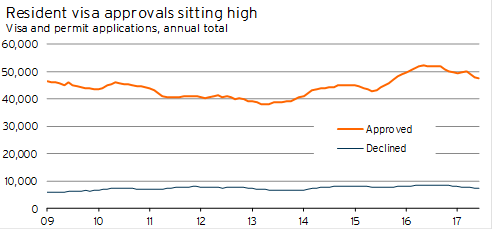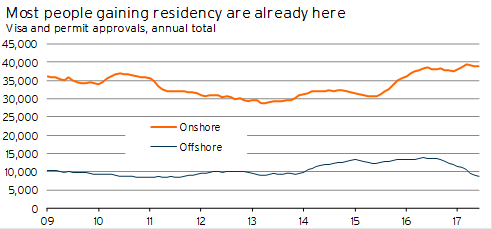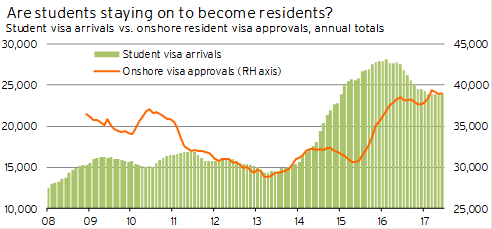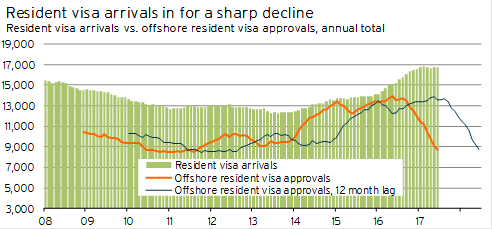Long-term implications of high net migration
New Zealand has gained around 72,000 more people in the past year according to arrival card data, and we’re feeling the strain of squeezing all these extra people into our cities. But further analysis of visa data suggests that there are longer-term implications for these high arrival levels that, if left unchecked, could pose a problem for policymakers when we come off the high point in the business cycle.
So what’s the real problem?
A big chunk of the lift in net migration over the last four years is due to people that government policy doesn’t have any controls on – Kiwis and Aussies coming from the other side of “the ditch”. But delving into the numbers a bit more shows that perhaps we should start tightening up on pathways to residency, particularly if we think about what New Zealand might look like when the business cycle enters into a downturn .
The main issue is the number of people that will have license to stay in New Zealand when we hit a downturn and employment growth dries up. The number of arrivals on resident visas is one indicator of how many people can stick around, but there are more round-about ways for people to get permanent residence – and those pathways are the ones we’re concerned about.
Resident visa approvals are higher than they used to be
Between the end of 2012 and June 2017, annual resident visa applications have lifted 19% and approvals have risen by 21%. These increases occurred in two bursts in late 2013 and in mid-2015, but the number of people who had their visa or permit1 applications declined has held stable at 7,500-8,500pa since 2011.
Graph 8

And are kept high by applications from people already in the country
Breaking visa approval data down by where people applied for their visas shows that the vast majority of people applying for resident visas are already in New Zealand. People applying for resident visas from onshore could already be here on a work visa, student visa, or partnership visa, or they could be visitors who have decided that they want to stay (and have been allowed to).
Graph 9

Growth in resident visa approvals is also stronger for onshore applications. The number of people who have been approved for resident visas that have applied from within New Zealand may have only increased 1.2% over the year to June 2017, but it has climbed 27% since June 2015.
The size of onshore visa applications relative to offshore applications highlights that arrival card data will not be completely representative of the number of people that end up staying in New Zealand long term. Migration is generally measured by arrival and departure cards. People who come into New Zealand with a resident visa will be counted, but people who became residents from within the country are usually counted in terms of the visa on which they arrived in the country.
As a result of using arrival card data to track migration, people arriving on student visas were initially thought to be somewhat temporary as migrants. There was an assumption that people who come here to study would generally return home at the end of their coursework. But the lift in onshore visa approvals 18 months after a lift in student arrivals suggests that a proportion of student arrivals might be more permanent than previously thought (see Graph 10).
Between 2013 and 2015, the number of students coming to New Zealand each year rose from 15,398 to 27,868 – an additional 12,500 people per year. Factoring in an 18-month period for people to transition from study into work, between mid-2015 and mid-2017, the number of people approved for visas from within New Zealand rose from 30,785 to 38,982 – an additional 8,000 people.
Without knowing the previous visa status of residence applicants, we cannot say for sure that this lift in onshore approvals was driven by the lift in student arrivals. But we think it is worth considering the effect student arrivals might have on future resident visa applications . If students are a key driver of onshore applications, the tightening of English language requirements for international students in late 2015 could lead to a decline in onshore resident visa applications during the rest of 2017 and 2018.
Graph 10

Offshore resident visa approvals are declining, indicating future decreases in resident visa arrivals
Approval data suggests that resident visa arrivals are set for a sharp decline. The number of people applying for resident visas from offshore has dropped 32% since rule changes were put in place in October last year. We estimate that the number of offshore resident visa approvals precedes resident visa arrivals by about 12 months, as applicants take time to prepare for their move once they’ve been approved. This lag means that the fall in offshore applicants has yet to really affect resident migrants as measured by arrival card data.
Graph 11

Furthermore, this drop-off in offshore resident visa approvals indicates that fewer people will become migrants using direct channels. Rising numbers of work visa arrivals, still-high numbers of people coming here on student visas, and elevated approvals for onshore visa applications all suggest that people applying for residency from within New Zealand are less affected by the rule changes.
Conclusion
A large proportion of people who apply for resident visas apply from within New Zealand, meaning that arrival card data doesn’t adequately record how many people are staying in the country long-term. Migration policy needs to carefully consider student and work migrants as potential residents and be appropriately tailored to focus on possible pathways to residency.
Will governemnt rule changes have a big effect on visa approvals? discusses the government’s October 2016 and April 2017 rule changes regarding resident and work visas. We break down resident and work visa approval data by applicant and occupation categories respectively. This breakdown gives some clues about how which these rule changes might affect the New Zealand labour market.
This article was part of an in-depth report on migration. Please find the full report here.
1 Permits were largely phased out by September 2013.


































